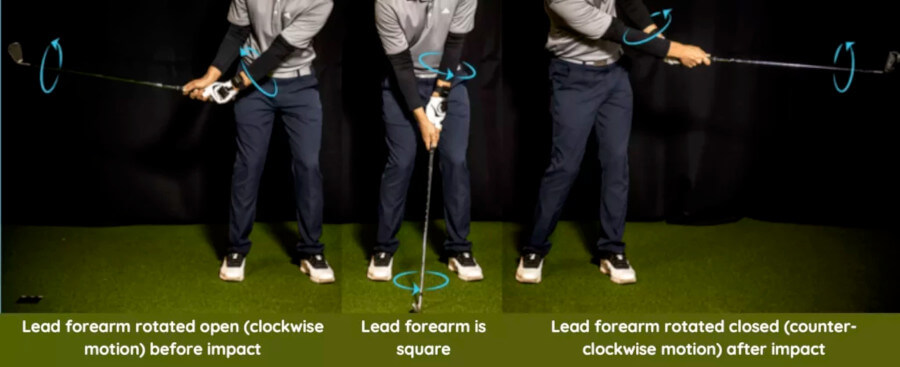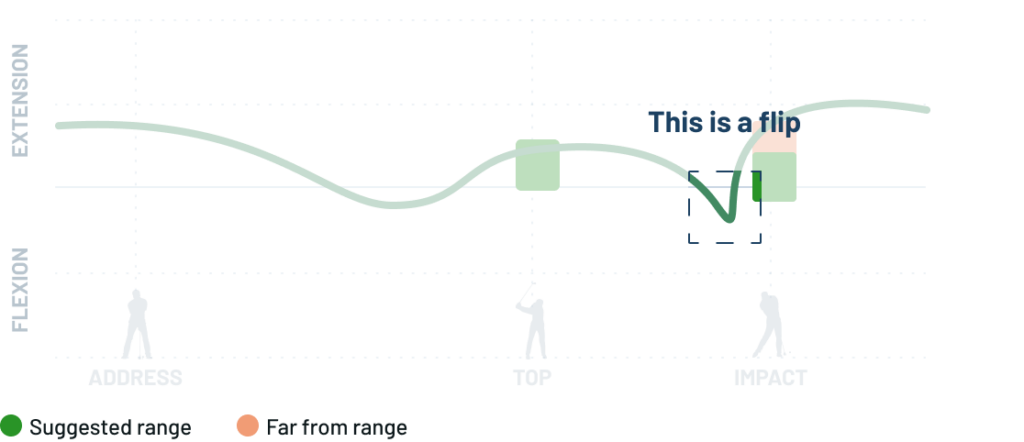If you are working on your ball flight direction at the driving range and want to better understand why your ball isn’t going in the direction that you want it to – then this article is for you!
What Determines Ball Flight?
Two factors determine where and how your ball flies, the clubface and the swing path.
- The clubface direction in relation to the target line determines the initial direction of the ball.
- The difference between the swing path and the clubface direction determines the curvature of the ball. (The ball will curve in the opposite direction of your swing path relative to your clubface)

What Determines the Clubface Angle?
There are two things that impact the clubface angle of a golf club.
Lead wrist flexion and extension

Lead forearm supination (rotation) at the bottom of the swing

How To Fix Every Type of Ball Flight
Since the ball’s flight direction is essentially determined by three factors:
- Extension at impact
- Lead wrist rotation
- Your swing path
We recommend getting your wrist within the HackMotion recommended impact position first, to eliminate the need to worry about all three variables and just focus on the remaining two.
Slice (Swing path is more closed than the clubface)
To fix the slice you’ll first need to match your clubface to your swing path.
By definition, your clubface will be more open than your swing path so you’ll want to close it to the point of pulling the golf ball.
- Make sure you get into the HackMotions recommended impact position
- Lead arm rotation should help you close the clubface if it feels as though it won’t shut.
- When you can feel the clubhead turning over, you will see more of a pull to the left; at this point, the clubface and the path will match.
Once you have learned how to pull the ball and aligned your clubface with your swing path, you can then focus on fixing the pull by changing your swing path.
Pull (Swing path is squared to the clubface, and the clubface is closed to the target line)
Now that you’ve matched your clubface to your swing path, it’s time to change the path to be more in-to-out, while still keeping the clubface square to the swing path.
- When fixing the pull, look at your HackMotion data at the top of the swing and check if you’re not over-extending your wrists at the Top which makes it easy to swing over the top and pull the ball. The opposite of what we want to do.
- To make sure that you’re not opening the clubface too much through extension when changing your path, keep trying to stay in the HackMotion recommended impact position.
Hook (Clubface is closed to the swing path)
With a hook, the clubface is closed to the swing path; the more closed it is, the more your golf ball is going to turn to the left.
The approach to fixing your Hook will depend on the severity of it.
If your swing path is within 5 degrees of the target line, then it is best to try to open the clubface and square it to the swing path.
- To not lose distance, use the lead arm rotation to open the face a bit; if you open the clubface with extension, you will add loft at impact.
- Double-check if you’re not flipping the ball shut at impact. A rather counterintuitive point to understand is that a flip usually shuts the face even if it shows up as a wrist extension at impact.

You can easily identify if you’re flipping by looking at your swing graph. If you see your extension values entering the recommended range during your downswing and the shoot back up before impact, that’s usually a tell-tell sign of a flip.
If you are struggling with a more severe hook (more than 5 degrees path to the target line), adjust your swing path to be a more out-to-in path and then work on adjusting the clubface angle.
Push (Swing path is squared to the clubface, and the clubface is open to the target line)
The first step here is to determine how severe your push is:
- For a small push, start closing your clubface a little through wrist rotation to draw the golf ball; your path is already quite good.
- If you have a large push, your path may be too in to out, keep the clubface square to the swing path and then slowly move the swing path to be more out to in.
Push slice (Clubface is open to the target line, swing path is closed to the clubface)
The first step is to determine how severe your push slice is:
- If the curve is small, you are dealing with a path issue and need to get your path a little more out to in.
- If the curve is big, your face is open, and you need to first start working out the face issues and squaring it with your clubface direction.
Pull Hook (Clubface is closed to the target line, swing path is open to the clubface)
With a pull hook, you first have to take a close look at the way the ball is reacting when it comes off the face of the club.
- If the ball starts left and goes straight or slightly left, you are dealing with a swing path issue.
- If the ball starts left and then turns hard left, you must first open the clubface before you work on the path.